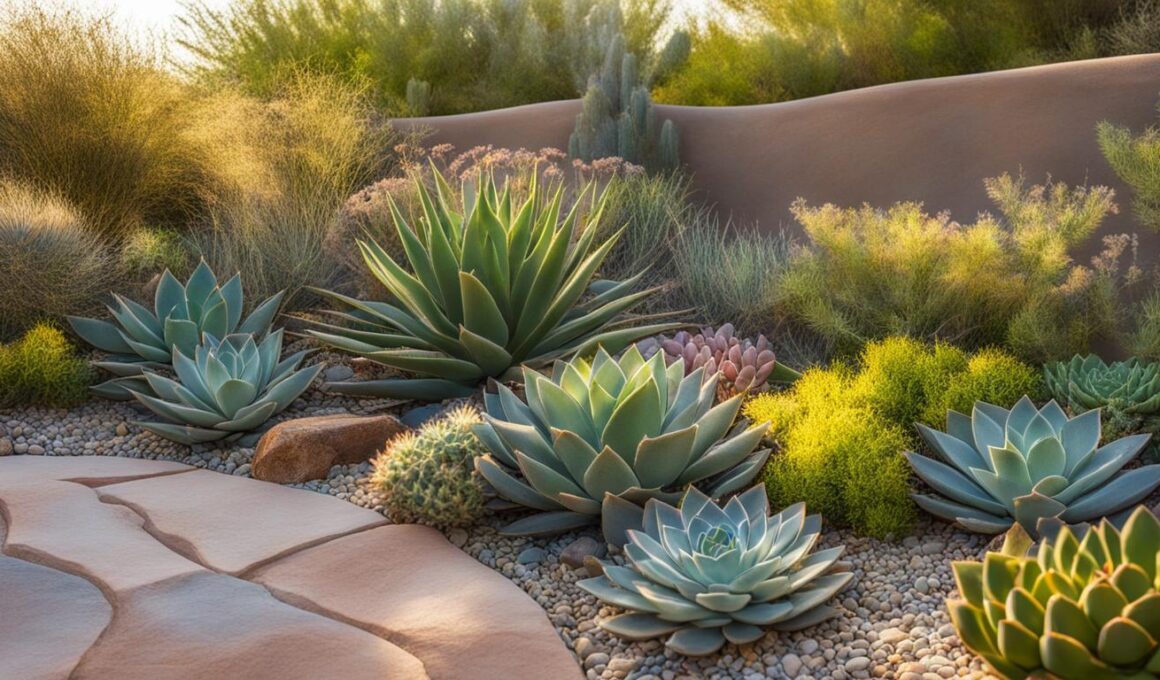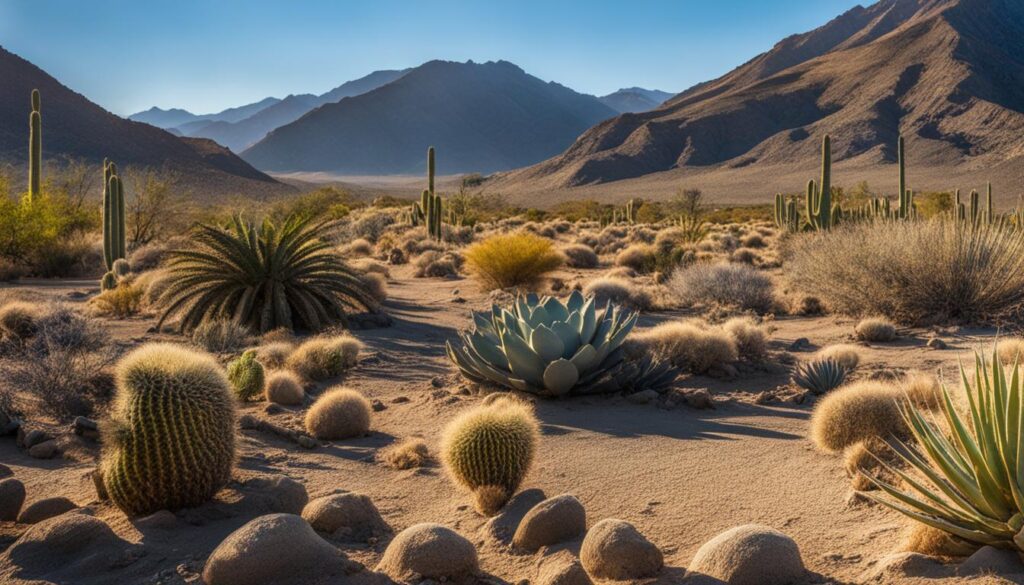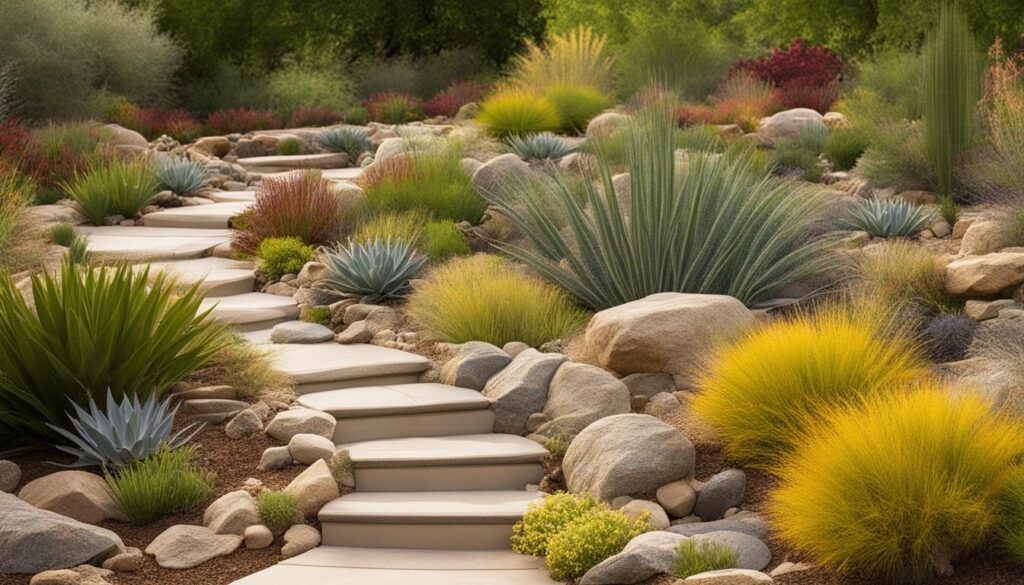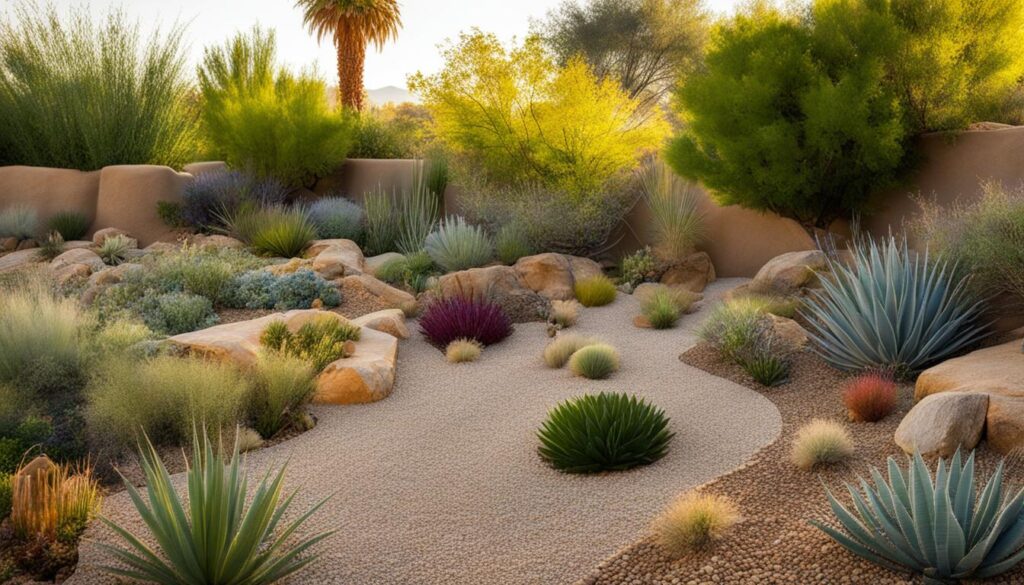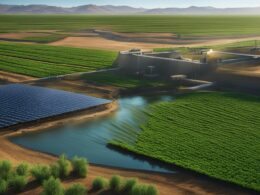Are you looking for ways to transform your garden into a water-saving landscape? With the DIY Xeriscape Garden Care Guide, you can create an eco-friendly garden that not only saves water but also enhances the beauty of your outdoor space. Whether you’re in a drought-prone area or simply want to reduce your water usage, xeriscaping is the perfect solution for sustainable garden care.
By implementing the principles of xeriscaping and making thoughtful choices about plant selection, irrigation methods, and maintenance, you can create a garden that thrives while conserving water resources. Say goodbye to high water bills and time-consuming yard work, and say hello to a vibrant and environmentally-friendly garden.
Key Takeaways:
- Xeriscaping is a water-saving landscaping method that reduces water usage by incorporating efficient irrigation and drought-tolerant plants.
- By following the seven principles of xeriscaping, including proper planning, soil improvements, and mulching, you can create a low-maintenance and eco-friendly garden.
- Xeriscaping benefits not only those in drought-prone areas but also individuals who want to conserve water resources and minimize the environmental impact of landscaping.
- The cost of xeriscaping can be significantly reduced by opting for a DIY approach and taking advantage of budget-friendly tips and turf replacement rebates.
- By implementing xeriscaping techniques, you can create a beautiful and sustainable garden that conserves water, reduces maintenance efforts, and benefits the environment.
What Is Xeriscaping?
Xeriscaping is a landscaping method that focuses on reducing water usage and creating a sustainable yard. It is especially popular in areas prone to drought, where water conservation is crucial. The goal of xeriscaping is to minimize the need for irrigation while maintaining a visually appealing and functional landscape.
Unlike traditional landscaping, which often relies on high water consumption, xeriscaping incorporates various practices to achieve water efficiency. These practices include efficient irrigation systems, such as drip irrigation or rainwater harvesting, as well as selecting drought-tolerant plants that require minimal watering. By choosing plants that are well-suited to the local climate and soil conditions, xeriscaping helps conserve water resources and reduces the overall environmental impact of landscaping.
“Xeriscaping is not just limited to drought-prone areas; it can be implemented in any yard.”
Xeriscaping is not just limited to drought-prone areas; it can be implemented in any yard. Whether you live in a region with frequent water restrictions or simply want to make your landscaping more eco-friendly, xeriscaping offers numerous benefits. By reducing water usage, xeriscaping can lead to lower water bills and a more sustainable approach to gardening. Additionally, xeriscaping creates a low-maintenance yard, as the chosen plants are adapted to the local climate and require less care and maintenance compared to traditional landscaping.
Incorporating xeriscaping into your yard:
- Research and select drought-tolerant plants suited to your climate;
- Improve soil quality and drainage to optimize water retention;
- Install efficient irrigation systems, such as drip irrigation or rainwater harvesting;
- Use mulch to conserve water, prevent weed growth, and protect plant roots;
- Consider alternatives to water-thirsty turf, such as native grasses or ground covers;
- Maintain your xeriscape yard by regularly monitoring and adjusting irrigation, removing weeds, and pruning plants as needed.
By implementing xeriscaping principles, you can create a beautiful and sustainable yard that not only saves water but also reduces the time and effort required for maintenance. Whether you are looking to conserve water during drought conditions or simply want to adopt a more eco-friendly approach to landscaping, xeriscaping is an excellent choice for creating a sustainable and visually appealing yard.
7 Principles of Xeriscaping
Xeriscaping, as an eco-friendly landscaping approach, follows seven key principles that contribute to water conservation, cost-effectiveness, and the overall health of your yard. By implementing these principles, you can create a sustainable and low-maintenance landscape that thrives even in water-scarce conditions.
1. Planning and Design
Start by assessing your yard’s unique characteristics, such as sunlight exposure, soil type, and drainage patterns. Plan and design your xeriscape garden accordingly, considering factors like plant placement, pathways, and focal points. This strategic approach will help maximize water efficiency and create an aesthetically pleasing landscape.
2. Soil Improvements
Enhancing your soil’s water retention and drainage capabilities is crucial in xeriscaping. Add organic matter, such as compost or mulch, to improve soil quality and water absorption. Amending the soil also promotes healthier root growth, leading to more resilient and water-efficient plants.
3. Efficient Irrigation
Implementing efficient irrigation methods is vital for water conservation. Use drip irrigation systems or soaker hoses instead of traditional sprinklers to deliver water directly to the roots, minimizing evaporation and water waste. Install rainwater collection systems to utilize natural precipitation and reduce reliance on municipal water sources.
4. Plant Zones
Group plants with similar water requirements together to create irrigation zones. This practice ensures that plants receive the appropriate amount of water without overwatering or underwatering. Consider using native plants or drought-tolerant species that are well-suited to your climate, as they require less water and maintenance.
5. Mulches
Apply mulch around plants and in garden beds to conserve moisture, suppress weed growth, and regulate soil temperature. Mulches also prevent soil erosion and add aesthetic appeal to your landscape. Use organic mulches like wood chips, straw, or leaves, as they break down over time and enrich the soil.
6. Turf Alternatives
Consider reducing or eliminating traditional turfgrass areas in favor of alternatives like drought-tolerant groundcovers, native grasses, or hardscaping elements. This helps conserve water resources and reduces the need for frequent mowing, chemical inputs, and intensive maintenance.
7. Maintenance
Regular maintenance is essential for a thriving xeriscape garden. Monitor soil moisture levels, prune plants appropriately, and remove weeds to ensure optimal water usage and plant health. By staying proactive in maintenance tasks, you can prevent issues and prolong the longevity of your eco-friendly landscape.
Following these seven principles of xeriscaping will enable you to create a visually appealing, sustainable, and water-efficient garden that requires less maintenance and preserves valuable water resources.
Who Benefits From Xeriscaping?
When it comes to xeriscaping, the benefits extend far beyond just the residents of drought-prone areas. While states like California, Arizona, Nevada, and Colorado can greatly benefit from xeriscaping during the dry and arid seasons, the advantages of this water-saving landscaping technique are applicable to anyone looking to conserve water resources and reduce their environmental impact.
Xeriscaping is a practical solution for water conservation. By minimizing the need for irrigation, you can significantly reduce water usage, which not only helps during periods of drought but also contributes to the overall sustainability of our water resources. Conserving water is a responsibility we all share, and xeriscaping provides an effective means to achieve this.
The environmental impact of xeriscaping is another impressive aspect. By using drought-tolerant plants, you can create an ecosystem that is better suited to the local climate and supports native wildlife. Native plants require less water, reduce the need for chemical pesticides, and provide habitats for birds, butterflies, and other pollinators. This promotes biodiversity and contributes to the overall health of our environment.
Xeriscaping benefits:
- Conserves water resources
- Reduces water bills
- Minimizes environmental impact
- Promotes biodiversity
- Requires less maintenance
Whether you’re facing a drought season or simply want to do your part in conserving water and protecting the environment, xeriscaping is a rewarding choice. With its numerous benefits, this landscaping technique allows you to create a beautiful and sustainable garden that harmonizes with nature while reducing your water consumption.
How Does Seasonal Care Affect the Maintenance of a Xeriscape Garden?
Seasonal yard care is crucial for maintaining a xeriscape garden. Xeriscaping requires minimal water, so understanding the specific needs of your plants during different seasons is essential. Proper care during the summer, winter, spring, and fall will ensure your xeriscape garden stays healthy and beautiful year-round.
How Much Does Xeriscaping Cost?
Xeriscaping offers a cost-effective solution for creating a sustainable and water-efficient garden. The overall cost of xeriscaping can vary depending on whether you choose to hire a professional or take the DIY route. Hiring a professional xeriscape landscaper can cost you around $5 to $20 per square foot, depending on the complexity of the project and your location. However, if you’re on a budget or enjoy getting your hands dirty, opting for a DIY approach can significantly reduce costs.
Here are some budget-friendly tips to help you keep the cost of xeriscaping down:
- Design the landscape yourself: By taking the time to plan and design your xeriscape garden, you can save money on hiring a designer.
- Do the physical labor: Instead of hiring professionals for every aspect of the project, roll up your sleeves and do the physical work yourself. This can include digging, planting, and installing irrigation systems.
- Buy seeds and plant cuttings: Purchasing seeds and plant cuttings is often more cost-effective than buying fully grown plants. Plus, it gives you the satisfaction of watching your garden grow from scratch.
- Use cost-effective elements: Look for affordable materials and elements like rocks, gravel, and mulch to create pathways and define different areas of your garden.
- Make your own mulch: Instead of buying expensive mulch, consider making your own by composting yard waste or using shredded leaves.
- Apply for turf replacement rebates: Some states offer rebates for replacing traditional lawns with water-saving alternatives. Research if you qualify for any rebates or incentives to further reduce costs.
Remember, xeriscaping is a long-term investment that can provide significant savings on your water bills and maintenance costs over time. By implementing these budget-friendly tips and taking a DIY approach, you can create a beautiful xeriscape garden without breaking the bank.
Professional vs DIY: Which Option Should You Choose?
Deciding between hiring a professional or doing it yourself depends on several factors. If you have a larger budget, limited time, or complex landscaping needs, hiring a professional xeriscaper might be the right choice for you. They can offer expertise, design assistance, and ensure your xeriscape garden is properly installed.
However, if you enjoy gardening, have a smaller budget, and want to learn new skills, taking the DIY approach can be a rewarding experience. It allows you to have full control over the design and implementation of your xeriscape garden while saving money on labor costs.
Ultimately, the decision comes down to your personal preference, budget, and the scope of your project. Whichever option you choose, xeriscaping offers a cost-effective and environmentally-friendly way to create a beautiful and sustainable garden that thrives with minimal water usage.
Conclusion
By following this DIY xeriscape garden care guide and implementing water-saving landscaping techniques, you can create a beautiful and sustainable garden that not only conserves water but also reduces maintenance efforts and benefits the environment. Xeriscaping is a practical and cost-effective solution for achieving an attractive and water-efficient yard, whether you live in a drought-prone area or simply want to be more eco-friendly.
This guide has provided you with the knowledge and principles of xeriscaping, including efficient irrigation methods, soil improvements, and selecting drought-tolerant plants. By grouping plants according to their water needs, using mulches to reduce water evaporation, and considering turf alternatives, you can create a low-maintenance yet stunning landscape.
In addition to the environmental benefits, xeriscaping also helps you save money on water bills and supports your local ecosystem. By conserving water resources and minimizing the environmental impact of water usage, you contribute to the preservation of aquatic habitats and biodiversity.
So why not take the first step towards a more sustainable and beautiful garden? Start implementing these eco-friendly gardening tips today and enjoy the rewards of a water-saving landscape that not only enhances your property but also makes a positive impact on the world around us.





